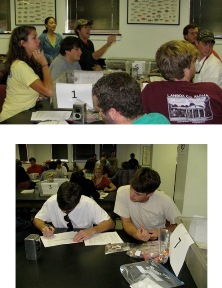ABSTRACTDuring a single lab period, students simulate colonization and drift in artificial communities to understand how these processes affect distributions of biodiversity in small versus large communities with varying degrees of isolation. Plastic bins represent islands, and are situated to represent different degrees of isolation. Ziploc bags of candy represent individuals in the communities and different candies inside the bags represent the genetic composition of the individuals. Students simulate colonization and drift in communities by tossing, replicating, and removing individuals from their communities. Students record which individuals and candies are removed from and added to their communities over time, graph their data, and discuss results.
AUTHORSAnna M. McKee1,2,3, Gary T. Green1, and John C. Maerz1 1Warnell School of Forestry and Natural Resources, The University of Georgia, Athens, GA 30602 2Current address: U.S. Geological Survey South Atlantic Water Science Center, Norcross, GA 30093 3Corresponding Author: Anna M. McKee (amckee@usgs.gov) CLASS TIMEThe activity alone may be completed during a two-hour lab session. However, additional time may be necessary for the introduction of theoretical concepts, which may be done during lecture or lab, and for the concluding discussion. If students calculate species richness and allelic richness on their own in class, additional time should be allowed. OUTSIDE OF CLASS TIMEStudents will need an additional 30 to 90 minutes to complete the discussion questions. Extension activities will require an extra 30 minutes to three hours depending on which activities are performed. STUDENT PRODUCTSStudents will answer questions from their handout. An optional activity is for students to perform a small literature review on the effect of neutral factors (i.e., area and isolation) and non-neutral factors (e.g., habitat features) on species and allelic richness and summarize the results from these studies. SETTINGThis lab may either be performed inside or outside. COURSE CONTEXTThis activity was developed for an undergraduate upper level course for natural resources majors. Classes of 20 – 30 students work best for the activity. However it may be conducted with as few as ten students or as many as 40 students. For larger classes, two sets of islands could be created, or additional islands could be added to the layout. INSTITUTIONThe University of Georgia is a land-grant and sea-grant institution that offers baccalaureate, professional, master’s, and doctoral and degrees. TRANSFERABILITYThis activity requires no special equipment or settings; therefore it could be used at any other institution. A basic background in evolution and ecology is helpful for students to obtain the most out of this activity. However, if this material has been covered previously in the semester, this activity could be appropriate for non-majors as well. DOWNLOADSDescription of other Resource Files:
ACKNOWLEDGMENTSThis activity was created at the University of Georgia for the course FANR3200 Ecology of Natural Resources taught by Drs. Jay Shelton, Daniel Markewitz, and Kamal Gandhi. Without the willingness of these professors to try a new lab and allow multiple semesters for improvement, this activity would not have been created. We thank the students of FANR3200 Fall 2010, Spring 2011, and Fall 2011 as well as WILD4550/6550 Spring 2011 for their participation with the formative evaluation of this activity and their suggestions for improvement. We also thank the members of Dr. John Maerz’s lab in 2010 and 2011 for their helpful feedback on the activity. Lincoln Larson provided valuable assistance with the statistical methods for validating the effectiveness of the activity. Two anonymous reviewers provided invaluable feedback on the manuscript. CITATIONAnna M. McKee, Gary T. Green, and John C. Maerz. 15 January 2015, posting date. Processes that Regulate Patterns of Species and Genetic Diversity Teaching Issues and Experiments in Ecology, Vol. 10: Experiment #2 [online]. http://tiee.esa.org/vol/v10/experiments/mckee/abstract.html |

Students participating in the biodiversity activity. a) One student creating a “colonization event” by tossing a bag of candy to another island community. b) Students recording species richness and allelic richness in their island community. Photos copyrighted by Anna M. McKee. full size image |
<top> | |